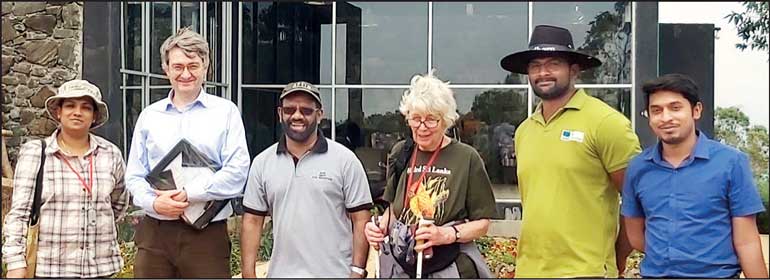Monday Dec 15, 2025
Monday Dec 15, 2025
Wednesday, 13 December 2023 00:10 - - {{hitsCtrl.values.hits}}

From left: Natural History Museum, London Lichen Expert Dr. Gothami Weerakoon, UKCEH Hub Lead Prof. Mark Sutton, University of Peradeniya Prof. S.P. Nissanka, Natural History Museum, London Retired Lichen Curator Patricia Woolsey, Dilmah Conservation Tharindu Prabashwara, and Research Assistant Shalika Welewani

Since 2020, the UKRI GCRF South Asian Nitrogen Hub (SANH), in collaboration with Dilmah Tea, Dilmah Conservation, and the University of Peradeniya, has been conducting a study on the impact of ammonia pollution within a tropical forest ecosystem. Emissions of ammonia to air represent a form of nitrogen waste, which is mainly lost from fertilisers and manures, reducing productive output in agriculture.
The project partners established an experimental site within the Rilagala Forest Sanctuary, adjacent to the Dilmah Queensberry Estate. Notably, South Asia has become a hotspot for nitrogen waste, leading Sri Lanka to lead international ambition to halve nitrogen waste by 2030, as declared during the Colombo Declaration of UN Day in 2019. The experimental site has now become a permanent monitoring plot.
Nitrogen, essential for food and protein production, poses a significant threat due to the excessive nitrogen waste generated from fossil fuel burning and the overuse of fertilisers. One key form of nitrogen release into the environment is ammonia, which can have adverse impacts on natural ecosystems and formation of fine particulate matter air pollution, which is damaging for human health.
The SANH research project addresses the pressing need for baseline data on the consequences of nitrogen pollution in much understudied South Asian Forest ecosystems, aiming to provide crucial insights for sustainable nitrogen management policies.
An integral part of this research involves the innovative use of a controlled ammonia enhancement system in forests, making it one of only two such sites globally. In this system the atmospheric ammonia pollution equivalent to a small farm is simulated. A system was developed to release ammonia only under specific wind conditions, ensuring it reaches designated areas where lichen and vegetation research plots are located.
The UKRI GCRF South Asian Nitrogen Hub (SANH) collaborates with 32 leading research organisations across South Asia and the UK. In Sri Lanka, the research team is led by Professor S.P. Nissanka of the University of Peradeniya, in partnership with the Hub lead Prof. Mark Sutton, of the UK Centre for Ecology and Hydrology, Edinburgh. Specific expertise is provided by Dr. Gothamie Weerakoon, an internationally renowned lichen expert based at the Natural History Museum, London who previously collaborated with Dilmah Tea on a book about lichens and Dr. Ajinkya Deshpande, an environmental ecologist at UKCEH.
Professor Nissanka commented: “This is a superb opportunity for Sri Lanka to demonstrate its international leadership in both nitrogen science and policy. The Rilagala experiment on ammonia is the first of its kind in the whole of Asia.”
Professor Sutton added, “We are looking at work to raise awareness by better understanding the key threats. For example, seeing how nitrogen pollution is damaging coral reefs, exacerbating the problem of climate change with coral bleaching, seeing how nitrogen is affecting forest biodiversity, which is little studied, and finally we are looking at bringing those fluxes and flows together.”
Dr. Deshpande emphasised, “This experiment serves as a platform on which other institutes can build, using it as an example of the critical importance of data collection. Our methodology can be replicated elsewhere, broadening the impact of our work.”
In 2020, a research site was established at 1,600 metres within the Rilagala Forest Reserve, which had been surrounded by Queensberry Estate tea plantations for nearly two centuries. This site offered ideal conditions and a rich biodiversity of lichen species, serving as effective bioindicators for monitoring nitrogen pollution.
Dr. Gothamie Weerakoon said, “The conclusions drawn from this data are crucial for sustainable farming, crop development, and improved livelihoods. If other corporate sector organisations who support such research, like Dilmah, come forward, it will illuminate the future of Sri Lanka and South Asia.”
Dilmah’s Climate Change Research Centre at Queensberry Estate in Nawalapitiya, the only privately owned climate change centre in Sri Lanka, has provided unwavering logistics support to the SANH team, even during the COVID-19 pandemic and economic crises, demonstrating their dedication to climate change research. Local student researchers working on the project are supported by Dilmah through the Climate Research Centre, offering them valuable exposure to international collaborators, and raising awareness about the impact of climate change.